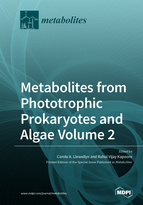Metabolites from Phototrophic Prokaryotes and Algae Volume 2
A special issue of Metabolites (ISSN 2218-1989). This special issue belongs to the section "Plant Metabolism".
Deadline for manuscript submissions: closed (30 June 2019) | Viewed by 43002
Special Issue Editors
Interests: microalgae; cyanobacteria; marine microbial ecology; algal natural products; ‘omics’
Special Issues, Collections and Topics in MDPI journals
Interests: metabolomics and lipidomics; co-culture techniques; microbial consortia; microalgal biotechnology (biorefinery); nutrient remediation and resource recovery
Special Issue Information
Dear Colleagues,
Algae (here including phototrophic prokaryotes) are a polyphyletic collection of aquatic organisms having an enormous diversity in terms of form and function. Ubiquitous in fresh and marine environments, their contribution to global primary production approximates that of terrestrial organisms and their role in regulating carbon and nitrogen cycles is essential to maintaining life on our planet.
In addition to the important ecological role that algae play in global carbon and nitrogen cycles, these organisms are increasingly emerging as being important in biotechnology. Their ability to fix carbon through photosynthesis, their high productivities compared to plants and the production of some unique groups of metabolites makes them an attractive proposition to fulfilling the drive towards a sustainable and low carbon bio-based circular economy.
However, our understanding of metabolism and metabolite production in algae currently lags behind that in plants. From an ecological perspective better understanding of metabolic pathways and metabolite production (both intracellular and extracellular) will lead to improved understanding on the role of algae in cycling elements within aquatic environments and to improved assessments of aquatic primary production. Additionally, from a biotechnological perspective, a better understanding will lead to improved yield and the ability to manipulate algal growth for bio-production purposes. There is also potential to apply our understanding on manipulation of metabolite pathways and production to plant and other non-plant systems.
From both an ecological and biotechnological perspective, we need improved understanding on acclimation and adaptation strategies to both abiotic (e.g., nutrients, light, temperature and salinity) and biotic factors (e.g., microbial consortia interactions, predator-prey interactions and bacterial/viral infection). In particular, we need improved understanding on shifts in allocation between primary and secondary metabolism and metabolites and on carbon and nitrogen allocation.
For this Special Issue we welcome research papers and reviews based around metabolomics to improve knowledge on the metabolome and metabolism in algae with a focus on carbon and nitrogen resource allocation. We welcome papers from an ecological or from a biotechnological and/or waste water remediation perspective through from single cell analysis to complex microbial consortia systems. Analytical approach focused papers, including extraction, technical measurements and bioinformatics, are also welcome.
Dr. Carole Llewellyn
Dr. Rahul Vijay Kapoore
Guest Editors
Manuscript Submission Information
Manuscripts should be submitted online at www.mdpi.com by registering and logging in to this website. Once you are registered, click here to go to the submission form. Manuscripts can be submitted until the deadline. All submissions that pass pre-check are peer-reviewed. Accepted papers will be published continuously in the journal (as soon as accepted) and will be listed together on the special issue website. Research articles, review articles as well as short communications are invited. For planned papers, a title and short abstract (about 100 words) can be sent to the Editorial Office for announcement on this website.
Submitted manuscripts should not have been published previously, nor be under consideration for publication elsewhere (except conference proceedings papers). All manuscripts are thoroughly refereed through a single-blind peer-review process. A guide for authors and other relevant information for submission of manuscripts is available on the Instructions for Authors page. Metabolites is an international peer-reviewed open access monthly journal published by MDPI.
Please visit the Instructions for Authors page before submitting a manuscript. The Article Processing Charge (APC) for publication in this open access journal is 2700 CHF (Swiss Francs). Submitted papers should be well formatted and use good English. Authors may use MDPI's English editing service prior to publication or during author revisions.
Keywords
- Stress adaptation
- Nutrient metabolism
- Biotechnology
- Ecology
- Physiology
- Metabolomics








